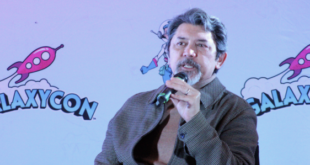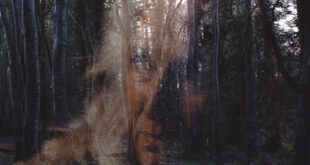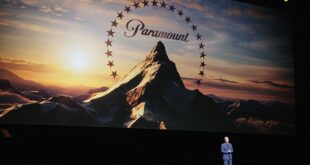There are two basic schools of thought regarding Peter Jackson's The Lord of the Rings trilogy, and by about the midway point in the first film, The Fellowship of the Ring, most people know where they stand. The first camp people can fall into is the group who believe that what Jackson created is nothing short of a masterwork — a brilliantly conceived and fully realized version of Tolkien's story; an emotional, dramatic, suspenseful epic. By the time the credits rolled on Fellowship people in this camp were already drawing up plans as to exactly when they would see The Two Towers and, quite possibly, where the best seats to watch the Battle of Helm's Deep were located.
The other camp is the group who decided the film was awfully long and simply couldn't wait for the credits to roll so they could go out for Chinese food. Though this may sound harsh, the latter group is wrong. The Lord of the Rings trilogy shows exactly what great filmmaking can and should be; it shows that action need not take a back seat to story and emotion in order to create an outstanding piece and what greatness can be wrought on screen by those who care deeply for the work.
The trilogy has now come to Blu-ray… mostly. While it's the sort of thing that fans and Blu-ray aficionados have been waiting for, they will not be impressed with this release, which has the feeling — despite the massive amount of lead time that had to go into it — of being a haphazard, slapdash effort. More on that later though; first let's look at the films themselves.
Many people are already exceedingly familiar with the story here, J.R.R. Tolkien's tale of the end of the Third Age of Middle Earth. The films, while they do work separately, are far more satisfyingly looked at as a single piece, one that is broken into three parts to be sure, but a single story nonetheless. The three films were conceived of and produced at the same time, and consequently truly need to be looked at together rather than separately.
The first film, The Fellowship of the Ring, puts the pieces in play, following the story of how a Hobbit, Frodo Baggins (Elijah Wood), came to possess the One Ring, to know its evil, and to set off to destroy it, thereby destroying the ultimate evil in the land, Sauron. Frodo is initially only accompanied by three other hobbits, Samwise "Sam" Gamgee (Sean Astin), Peregrin "Pippin" Took (Billy Boyd), and Meriadoc "Merry" Brandybuck (Dominic Monaghan). At that point their quest is a small one – take a short journey a couple of towns over and meet up with Gandalf the Grey (Ian McKellen). Sadly for them, Gandalf isn't present at that meeting and they are forced to continue on with the stranger Ranger from the north, Strider (Viggo Mortensen).
Though all of that prelude is crucially important (and terribly interesting to see put on screen), the story really gets going in the second half of the first movie, when the Hobbits and Strider reach Rivendell. It is there where the full scope of their quest becomes apparent and where the Fellowship is formed. The Hobbits and Strider (whose real name is Aragorn and who is of royal blood) join forces with Gandalf; an Elf, Legolas (Orlando Bloom); Gimli (John Rhys-Davies); and a human, Boromir (Sean Bean). The nine individuals are tasked with heading to Mordor, the home of Sauron, to throw the One Ring into the fire within Mount Doom, the place where the ring was forged and the one place it can be broken.
Fellowship, as do the other two films, takes some liberties with the story as Tolkien wrote it. Those liberties tend to be relatively small and at times include the incorporation of other material written by Tolkien that relates to the characters and time period but wasn't included within the three stories proper. Some of the other changes include the slight rearrangement of what the audience – or reader – learns about the characters, and the exact moment in the tale at which the film ends and the next begins. There are, assuredly, Tolkien purists out there who will be upset with these changes (and really one can't completely fault them — seeing Tom Bombadil would have been great), but by and large the films, though epic and expansive (and all with a runtime in the neighborhood of three hours) are beautifully crafted, with little extraneous material.
By The Two Towers, the story of the characters is split in several directions, with the Fellowship no longer in existence. Frodo and Sam find themselves led ever closer to Mordor by Gollum (Andy Serkis), whereas Merry and Pippin have been abducted by the once good but now evil wizard, Saruman (Christopher Lee). Aragorn, Gimli, and Legolas are hot on the tale of those two Hobbits.
Finally, in The Return of the King, not only do we get to see the culmination of Frodo's quest, but Aragorn's return to his ancestral homeland, and the true closing of the Age. This third film, though some may quibble with the large number of endings it contains, may very well be the best of the three. And while the extended closing might be inappropriate for a single film, one must remember that it isn't the close of a single film, but rather the close of a three-film, nine-hour epic.
As most people are aware, Tolkien wrote far more books about Middle Earth than just this trilogy and The Hobbit. Consequently, there is a ton of backstory, side story, and all manner of other bits and pieces of information that this trilogy is informed by. Jackson and company manage to brilliantly sift through all of that information, giving compelling bits of backstory to nearly all of the characters, thereby managing to create complete pictures of who these people are and why they act in the manner they do.
That is all to do the good – the theatrical versions of the films, which is what this set includes, are wonderful examples of epic filmmaking and how to perfectly incorporate CGI in employment of plot and story not as a substitute for either or both. What is not good, where this set fails, is in its presentation, which, as stated above, feels incredibly slipshod.
In terms of video, despite the fact that all three films were shot at the same time and were all released within two years of one another, they look and sound different here in this release. There is no other way to express the feelings one will have looking at the visuals of Fellowship than by saying that disappointment will abound. The textures and look vary greatly from scene to scene, at times being relatively sharp and at other times appearing quite muddled. In several outdoor scenes there is a distinct flicker as well. Two Towers looks better than Fellowship, with far greater amounts of detail apparent in clothes, mountains, and Treebeards (well, trees in general as Treebeard doesn't appear until the second film). Two Towers though, in general, is a darker film than the first and as the visuals are most disappointing in bright light in Fellowship, it is possible that one of the reasons Towers looks better is that far more of it is in the dark. Return of the King is, unquestionably, the best of three and looks as good as one would have hoped the entire trilogy to be. Additionally – and perhaps oddly – while the CGI in the first two films looks good, it is far more readily apparent that things are computer generated there than in Return of the King.
The sound, a DTS-HD Master Audio 6.1 track on all three films, is quite good all around. It too does improve from one film to the next, but one won't have any sense of disappointment from the sound in the first two films as they will with the visuals. The surrounds are well utilized and if you happen to look down at the wrong time in any film you might swear that a horse just galloped directly in front of you or an arrow whizzed by your ear. Return of the King just takes that very good audio and raises it a notch. This, in part, may be due to the fact that this film has the greatest chance to utilize the audio track with it featuring the climax of the trilogy, but the battle of Helm's Deep in Towers is pretty climactic but not quite as immersive as the battle in King.
As for the rest of the set, which oddly is described on the packaging as containing six discs instead of the nine that are actually present, the discs are all standard DVDs instead of Blu-ray discs (it is made clear on the packaging that's the case), and all of the bonus features contained on those discs consist of previously released material. In fact, the only new special features on the set are the BD-Live access, the digital copies, and a trailer on the feature film discs for an upcoming LOTR game, War in the North (there are also other HD trailers included, which are new to HD, but not new). It is unquestionably true that the earlier releases of the trilogy (both the extended and regular editions) were truly impressive in the amount of bonus material they contained, but it still seems rather improbable that nothing else could be unearthed, or created, for this new release.
As for that previously released material, it includes a plethora of lordoftherings.net featurettes, and a whole lot of other documentaries (many of which have more of a promotional than behind-the-scenes, warts and all feel) including specials that aired on FOX, Sci-Fi, and Starz Encore. One of the oddest inclusions is a short film made by Sean Astin with some of the LOTR cast and crew during the filming of the actual movie. This short, "The Long and the Short of It," is the tale of a painter who gets some help putting up a sign. While it is merely an oddity, the "making of" featurette for "The Long and the Short of It" is also included – and is in fact longer than the short itself. It is also funnier and perhaps better made. However, the point of both is less the quality and more the camaraderie – the cast and crew of the trilogy were clearly people who liked each other and the project, and that not only comes across in the main features, but in this bonus one as well.
While there are, as noted, a lot of special features, three DVDs worth (the last three discs of the set contain the digital copies), but with only the single trailer for the game being new, one can't help but feel a sense of disappointment, almost as much disappointment as one will garner from seeing the boring, static menus that accompany the main features. Those who purchased the extended edition DVDs are well aware of how great a look and feel the menus for the trilogy can be given, but the ones included here have a bargain basement feel, the same bargain basement feel the use of recycled materials and subpar visuals give the entire set.
The Lord of the Rings trilogy will be released as an extended edition in the future (rumor has it the release will coincide with The Hobbit hitting theaters), and though the extended editions require more time to get through, they take the already excellent films and elevate them further. True fans of the series are undoubtedly waiting for the extended editions to be made available, and due to the distinctly distressing quality of the Blu-ray editions in this set, this reviewer has to recommend that anyone who wants their fantasy fix in Blu-ray wait to see what that set looks like (literally). For the love and care that clearly went into making the best trilogy of fantasy films in recent memory (and perhaps of all time) to be released in such a sub-par, nearly cash-in quality set is more than just a letdown, it is truly flabbergasting.
 Blogcritics The critical lens on today's culture & entertainment
Blogcritics The critical lens on today's culture & entertainment



